
I’m white. Really white.
I often joke that my skin has two equally lovely shades. In the winter, I’m Casper-white. And in the summer if I’m not careful, I’m lobster-red.
As much as I may joke about my own whiteness, teachers like me have a natural inclination to get defensive when someone calls out our whiteness in relation to our practice. Resisting the urge to get defensive, though, might be one of the most important moves we make in our professional lives.
I’ll never forget the conversation I had with a teacher who was new to our district. She complained that our book choices were “too white.” Right away, I felt my defensive barbs prickle, and a million responses rushed to the tip of my tongue. Like, Are you kidding? You should have seen what it used to be!
Thankfully, though, I bit my tongue and, instead of snapping back, I took a deep breath and responded, “Tell me about it . . . . No really, tell me about it.”
Then I listened as she told me where she noticed holes in representation. It was nice to get an outside perspective because, as someone who was new, she could look at our curriculum in ways that I couldn’t. And now I’m sure that she learned more about who I am because I listened un-defensively.
Start with a Descriptive Inventory
Even though it can be hard to resist the urge to get defensive, I’ve found that stepping back to listen can make a world of difference. And I don’t just mean listening when someone is confronting me.
Do you remember that exercise in your undergrad class? The one where you had to observe a class and tally how many times a teacher called on each student. You collected the information first, then backed up to do some thinking and analysis. Do the same here.
Start by gathering observations–lots of them. Save the analysis and conclusions for later and just record what you notice is happening in class. By doing this sort of inventory, you can listen to many aspects of your practice: your students, yourself and your instruction, your curriculum. You might be someone who collects this thinking in lists or spreadsheets or simply by saying them out loud.
Once you’ve got the observations, it will be time to take a step back and reflect on what patterns you notice about whose voices and values are being represented in your class. Is it actually as diverse as you’d hoped it was? I’ve found that taking the time to make some unbiased observations helped me to better realize when my perceptions, and my privilege, might be getting in the way of real reflection–and might be unintentionally causing me to get defensive.
My first step in getting there was to look at some important areas of my practice. To get started on your own journey, you might start your inventory with the following areas.
Inventory Your Students
Describe what you know about your class. Tally, chart, or describe what you know about each student in relation to their:
- Race
- Religion
- Geographic origin
- Languages spoken
- Gender identity
- Sexuality
- Family
- Socio-economic status
- Interests
- Values
Among other benefits, this exercise helped me realize when I needed to get to know a student better.
Next, ask the same questions about yourself as you would your students. And if you’re really feeling adventurous, ask your students to do the inventory on you.
Inventory Your Instruction
Consider:
- Who do you call on when you’re looking for answers?
- Who do you “check in on” to make sure they’re getting it?
- Who do you push with extension or more challenging opportunities?
- Who volunteers to speak in class? Who doesn’t?
- What opportunities do you give for students to talk to each other?
- How often do students speak to someone inside their social circle? Outside it?
- What opportunities do students have to give you feedback?
Do the same kind of inventory on the books in your classroom. Get ready to look not only for holes when people aren’t represented, but also for stereotypes that might be perpetuated.
Step Back and Reflect
It’s now time to reflect on all that you’ve noticed. Ask yourself:
- What patterns do you see?
- Who is represented? Who isn’t?
- Whose viewpoints seem to be given the most voice or value?
- What stereotypes are present, perpetuated, or disputed?
- Which students are given opportunities to see themselves, their families, their friends, their values represented in books?
- Which students get to see and experience others’ perspectives and cultures through books?
This kind of reflection isn’t something that you do in just one sitting. And it can be uncomfortable–really uncomfortable. But once you start, it’s tough to deny that it’s some of the most important work we can do–for ourselves, for our instruction, and most importantly, for our students.
 Megan Kortlandt (@megankortlandt) is a secondary ELA consultant and reading specialist for the Waterford School District. In the mornings, she teaches at Durant High School, and in the afternoons, she works with all of Waterford’s middle and high school teachers and students through the Curriculum, Instruction, and Assessment department. Every time Megan goes grocery shopping, her cart makes her appear to be exceptionally healthy, but don’t be fooled. The healthy stuff is all for her pet rabbit, Hans.
Megan Kortlandt (@megankortlandt) is a secondary ELA consultant and reading specialist for the Waterford School District. In the mornings, she teaches at Durant High School, and in the afternoons, she works with all of Waterford’s middle and high school teachers and students through the Curriculum, Instruction, and Assessment department. Every time Megan goes grocery shopping, her cart makes her appear to be exceptionally healthy, but don’t be fooled. The healthy stuff is all for her pet rabbit, Hans.

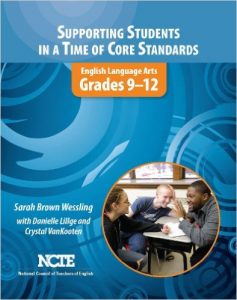
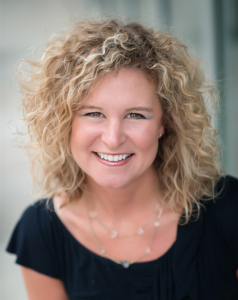 Sarah Brown Wessling
Sarah Brown Wessling My mom always used to say, “There’s more than one way to skin a cat.”
My mom always used to say, “There’s more than one way to skin a cat.”  This was the most important part, I think. After the unit, we shared our different approaches and what had gone well.
This was the most important part, I think. After the unit, we shared our different approaches and what had gone well. 
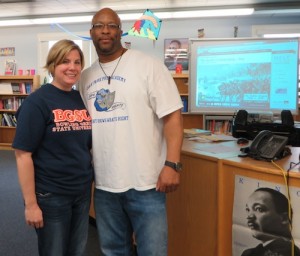
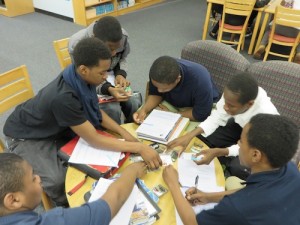
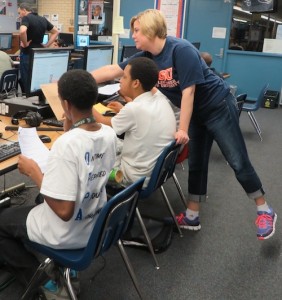 This experience showed me and Doug that it is imperative for disciplines to collaborate. Neither of us could have gotten the quality of work the students produced had we done this separately. For the first time, students were seeing exactly how the skills they learn in their individual classes apply to all classes. They were developing skills–research skills, presentation skills– not just memorizing facts and figures.
This experience showed me and Doug that it is imperative for disciplines to collaborate. Neither of us could have gotten the quality of work the students produced had we done this separately. For the first time, students were seeing exactly how the skills they learn in their individual classes apply to all classes. They were developing skills–research skills, presentation skills– not just memorizing facts and figures. Lisa Kraiza teachers eighth grade English Language Arts at Oak Park Preparatory Academy. She is also a member of the Core Leadership Team of the
Lisa Kraiza teachers eighth grade English Language Arts at Oak Park Preparatory Academy. She is also a member of the Core Leadership Team of the